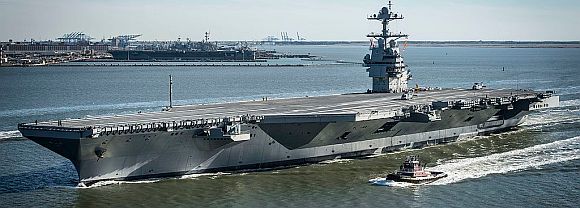 The US Navy’s newest aircraft carrier, USS Gerald R. Ford, is the largest aircraft carrier ever built and, at over $13 billion, is also the most expensive. Nevertheless, because of problems with mission-critical systems, the ship has been referred to by one critic as nothing more than a “nuclear-powered berthing barge.”
The US Navy’s newest aircraft carrier, USS Gerald R. Ford, is the largest aircraft carrier ever built and, at over $13 billion, is also the most expensive. Nevertheless, because of problems with mission-critical systems, the ship has been referred to by one critic as nothing more than a “nuclear-powered berthing barge.”
Unfortunately, a recent GAO report on unaccounted maintenance costs suggests that the Ford may not be so great as a berthing barge either. The problem? The toilets and the entire sewage system tends to get easily clogged. When this happens, the Navy has to flush the system with acid to clear it at a reported cost of $400,000. How often does this happen? The GAO says that the Navy cannot say.
From the report: According to fleet maintenance officials, while each acid flush costs about $400,000, the Navy has yet to determine how often and for how many ships this action will need to be repeated, making the full cost impact difficult to quantify.
The GAO uses the costly clogged sewage system as one example of “underestimated sustainment costs” contributing to a total of $130 billion of additional costs across six shipbuilding programs.
This might be understandable if it was a new problem. The Ford, after all, is not expected to ready for her first deployment until 2022, or possibly 2024. The Ford is, however, not the first US carrier with these toilet problems.
Over 8 years ago, we posted about similar toilet issues on the last Nimitz Class carrier, the USS George H.W. Bush. From our post of October 2011: Since it deployed in May, the new carrier has suffered from widespread plumbing failures, which, at times, rendered the entire ship without a single working head. With remarkable understatement, the crew has complained that the lack of toilets has “affected their morale, health and job performance.” The problem has been ongoing for six months. The Navy is blaming the sailors, who are blaming the design of the vacuum toilet system.
So apparently, the sewage system problems on the USS George H.W. Bush are now shared with the USS Gerald R. Ford, and, no doubt, the follow-on ships of her class.

The US Navy needs to stop contracting on a cost plus basis. And then not take acceptance until the thing works properly. Right now they need to give it back to Northrup Grumman and not give them another penny on future contracts until everything passes a stringent sea trials over an extended at sea period, not this out and in 2 days later and call it good.
If clogged toilets are not in the picture, it must not be a boat.
More seriously: curious to know if acid wash is due to flushing with salt water, the old urine crystallization problem? Surely not?
The system is described as based on the toilet and sewage systems found on commercial airliners, just scaled up for 4,000 users.
Back when I was aboard Ike, the Hull Techs had to periodically use a special power washer to flush out the plumbing when it clogged. Part of the problem is moving sewage effectively when you cannot use a simple gravity feed. A lot of sewage tends to remain in certain pipes depending on the ship’s trim. Sloshing in those same pipes during rough seas can create water hammers strong enough to rupture the pipe.
Big problems need big solutions, but half-baked solutions are no solution at all. Add the Ford’s flukey sewage system to her Catapult, arresting gear, weapons elevators, and other problems on supposedly advanced shipboard systems.